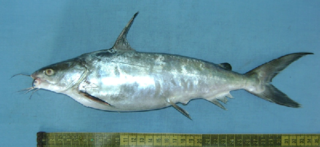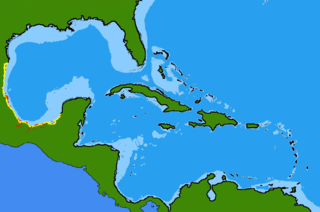
The giant catfish, also known as the giant sea catfish, giant salmon catfish, giant marine-catfish, or the khagga, is a species of catfish in the family Ariidae. It was described by Eduard Rüppell in 1837, originally under the genus Bagrus. It inhabits estuaries and occasionally freshwater bodies, in Japan, Australia, Polynesia, southern Vietnam in the Mekong Delta, the Red Sea and the northwestern Indian Ocean. It dwells at a depth range of 10 to 195 m. It reaches a maximum total length of 185 cm (73 in), but usually reaches a TL of 70 cm (28 in).

Cathorops is a genus of catfishes in the family Ariidae found in the Atlantic and Pacific Oceans. These species are found in the eastern and western Central and South America in brackish and freshwater habitats. This genus is a strongly supported clade of this family. It consists of a natural group in which the monophyly is well-defined by morphological and molecular evidence and the genus probably includes several unrecognized species from both American coasts.
The Bressou sea catfish, also called the marine catfish, is a species of sea catfish in the family Ariidae. It was described by Achille Valenciennes in 1840, originally under the genus Arius. It inhabits tropical marine, brackish and freshwater on the Atlantic coast of South America, ranging from Guyana to Brazil. It reaches a maximum total length of 50 cm (20 in), but more commonly reaches a TL of 30 cm (12 in).

The coco sea catfish is a species of sea catfish in the family Ariidae. It was described by Carl Linnaeus in 1776, originally under the genus Silurus. It inhabits tropical marine and brackish waters ranging between Colombia and the Amazon River, in South America. It dwells at a maximum depth of 50 m (160 ft). It reaches a maximum total length of 55 cm (22 in), more commonly reaching 40 cm (16 in).
Cathorops agassizii is a species of sea catfish in the family Ariidae. It was described by Carl H. and Rosa Smith Eigenmann in 1888, originally under the genus Tachisurus. It is a tropical freshwater fish which is known from Guyana and Brazil. It reaches a maximum length of 32 cm (13 in).

The estuarine sea catfish, also known as the Aguadulce sea catfish, is a species of sea catfish in the family Ariidae. It was described by Seth Eugene Meek in 1904, originally under the genus Galeichthys. It is a tropical fish which is known from Mexico to Guatemala, where it typically inhabits freshwater rivers, lagoons, and drainages, also sometimes dwelling in marine waters. It reaches a maximum standard length of 22.7 cm (8.9 in).

The Mapale sea catfish, is a species of sea catfish in the family Ariidae. It is a tropical fish which is known from Colombia to west Venezuela, where it typically inhabits freshwaters, brackish, in coastal lagoons and near-shore marine waters. It reaches a maximum standard length of 30.6 cm (12.0 in).
The papillate sea catfish, also known as the Kailola's sea catfish, is a species of sea catfish in the family Ariidae. It was described by Alexandre Pires Marceniuk and Ricardo Betancur-Rodríguez in 2008. It is a tropical fresh and saltwater catfish which occurs in Central America. It reaches a standard length of 25.4 cm (10.0 in).
The Conguito sea catfish is a species of catfish in the family Ariidae. It was described by Susan Brown Bristol in 1897. It is a tropical, freshwater catfish which occurs in Mexico. It reaches a standard length of 19.7 cm (7.8 in).
The Dark sea catfish is a species of catfish in the family Ariidae. It was described by Albert Günther in 1864. It is a tropical, freshwater catfish which occurs in Guatemala. It reaches a total length of 23 cm (9.1 in).

The Box sea catfish is a species of catfish in the family Ariidae. It was described by Albert Günther in 1864. It is a tropical, marine catfish which occurs in Guatemala, Costa Rica, El Salvador, Colombia, Peru, Ecuador, Mexico, Nicaragua, Honduras, and Panama. It dwells at a maximum depth of 20 m (66 ft). It reaches a 30 cm (12 in).
The Orinoco sea catfish is a species of catfish in the family Ariidae. It was described by Albert Günther in 1864. It is a tropical, fresh and saltwater catfish which occurs between Venezuela and Guyana. It reaches a standard length of 24.5 cm (9.6 in).

The Steindachner's sea catfish is a species of catfish in the family Ariidae. It was described by Charles Henry Gilbert and Edwin Chapin Starks in 1904. It is a tropical, marine and freshwater-dwelling catfish which occurs between Costa Rica and Peru. It dwells at a maximum depth of 20 m (66 ft). It reaches a maximum total length of 36 cm (14 in), more commonly reaching a TL of 20 cm (7.9 in).

Genidens genidens, the Guri sea catfish or marine catfish, is a species of catfish in the family Ariidae. It was described by Georges Cuvier in 1829, originally under the genus Pimelodus. It is known from southern South American rivers connected to the Atlantic Ocean. It is known to reach a total length of 42.5 cm (16.7 in), but more commonly reaches a TL of 35 cm (14 in). It has been recorded spawning between Autumn and Spring. Its diet includes polychaete worms, plants, finfish, mollusks, and benthic crustaceans.
The salmon catfish, also known as the boofhead catfish, the freshwater forked tailed catfish, the lesser salmon catfish, and the triangular shield catfish, is a species of catfish in the family Ariidae. It was described by Pieter Bleeker in 1862, originally under the genus Hexanematichthys. It inhabits marine, brackish and freshwaters in Australia and New Guinea, at a maximum known depth of 135 m (443 ft). It reaches a maximum standard length of 60 cm (24 in).

The blacktip sea catfish, also known as the Dussumier's catfish, the giant marine cat fish, the Shupanga sea catfish, or the tropical seacatfish, is a species of catfish in the family Ariidae. It was described by Achille Valenciennes in 1840, originally under the genus Arius. It inhabits rivers and marine waters ranging between Africa and India in the Indo-western Pacific. It dwells at a depth range of 20 to 50 m. It reaches a maximum standard length of 62 cm (24 in), and a maximum weight of 1.4 kg (3.1 lb).
The thinspine sea catfish, also known as the Day's catfish, is a species of catfish in the family Ariidae. It was described by Francis Day in 1866, originally under the genus Arius. It inhabits brackish and coastal marine waters in Mozambique, Sri Lanka, and the Persian Gulf. It dwells at a depth range of 20 to 50 m. It reaches a maximum total length of 36 cm (14 in), more commonly reaching a TL of 23 cm (9.1 in).
The Couma sea catfish, also known as the Pemecou sea catfish, is a species of catfish in the family Ariidae. It was described by Achille Valenciennes in 1840, originally under the genus Bagrus. It inhabits estuaries and rivers in Guyana, French Guiana, Suriname, Brazil, Trinidad and Tobago, and Venezuela. It reaches a maximum total length of 97 cm (38 in), more commonly reaching a TL of 50 cm (20 in). It reaches a maximum weight of 30 kg (66 lb). Its maximum known life expectancy is 5 years.

The Pemecou sea catfish, also known as the flapnose sea catfish, the mud cuirass, or the gillbacker, is a species of catfish in the family Ariidae. It was described by Marcus Elieser Bloch in 1794, originally under the genus Silurus. It inhabits marine, brackish and freshwaters in Brazil, Guyana, French Guiana, Colombia, Suriname, Venezuela, and Trinidad and Tobago. It dwells at a depth range of 1 to 5 m. It reaches a maximum total length of 94.2 cm (37.1 in), while males more commonly reach a TL of 30 cm (12 in) and females reach a TL of 62.5 cm (24.6 in). It reaches a maximum weight of 1.5 kg (3.3 lb).
The flapnose sea catfish, also known as the brown sea catfish, is a species of catfish in the family Ariidae. It was described by Theodore Gill in 1863, originally under the genus Leptarius. It inhabits rivers and estuaries in Ecuador, Colombia, Guatemala, Costa Rica, El Salvador, Panama, Honduras, Nicaragua, Mexico, and Peru. It dwells at a depth range of 0 to 15 m. It reaches a maximum total length of 90 cm (35 in), more commonly reaching a TL of 50 cm (20 in).










